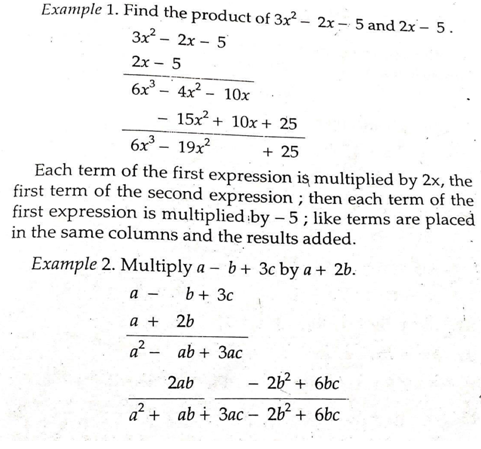CLASS-6
MULTIPLICATION OF ALGEBRAIC EXPRESSION OF BINOMIAL BY TRINOMIAL
MULTIPLICATION OF ALGEBRAIC EXPRESSION OF BINOMIAL BY TRINOMIAL -
Multiplying an algebraic expression of a trinomial by a binomial is a common operation in algebra. To do this, you can use the distributive property (also known as the FOIL method when multiplying a binomial by a binomial). Here's how you can multiply a trinomial by a binomial step by step:
Let's say you have a trinomial, such as ax²+ bx + c, and a binomial, such as dx + e, and you want to multiply them together.
- Start by multiplying the first term of the trinomial (ax²) by each term of the binomial (dx and e):
ax²⋅dx = adx³
ax²⋅e = aex²
2. Next, multiply the second term of the trinomial (bx) by each term of the binomial:-
2bx⋅dx = bdx²
bx⋅e = bex
3. Finally, multiply the third term of the trinomial (c) by each term of the binomial:-
c⋅dx = cdx
c⋅e = ce
4. Now, add up all the products you obtained in steps 1, 2, and 3 to get the final result:
adx³+ aex²+ bdx²+ bex + cdx + ce
This is the product of the trinomial ax²+ bx + c and the binomial dx + e.
You can simplify the expression further by combining like terms if necessary.
Keep in mind that this process follows the distributive property, which states that for any real numbers or algebraic expressions a, b, c, d, and e:
(a+b) ⋅ (c+d+e) = ac + ad + ae + bc + bd + be
So, when you multiply a trinomial by a binomial, you apply this property repeatedly to each term in the trinomial and each term in the binomial.
ANOTHER WAY OF UNDERSTANDING -
Multiplying an algebraic expression of a trinomial by a binomial involves applying the distributive property of multiplication over addition (or subtraction). Here's how you can do it step by step:
Let's say you have a trinomial, such as ax²+ bx + c, and a binomial, such as dx + e. To multiply the trinomial by the binomial, follow these steps:
1. Distribute the first term of the binomial (dx) to each term in the trinomial:-
(ax²+ bx + c) (dx) = ax²(dx) + bx (dx) + c (dx)
2. Distribute the second term of the binomial (e) to each term in the trinomial:-
(ax²+ bx + c) (e) = ax²(e) + bx (e) + c (e)
3. Now, you have two sets of terms from the distribution in step 1 and step 2:
Set 1:- ax²(dx), bx (dx), c (dx)
Set 2:- ax²(e), bx (e), c (e)
4. Finally, combine the like terms in each set:-
Set 1:- ax² (dx) + bx (dx) + c (dx) = (adx²) + (bdx) + (cdx)
Set 2:- ax²(e) + bx (e) + c(e) = (aex²) + (be) + (ce)
Now, you have two simplified expressions:
(ax²+ bx +c) (dx + e) = (adx²+ bdx + cdx) + (aex²+ be + ce)
You can further simplify or combine like terms if needed. This is the result of multiplying an algebraic expression of a trinomial by a binomial using the distributive property.
Example.1) Multiplication of (4x + 2) and (x + y + z) will be
(4x²+ 4xy + 4xz + 2x + 2y +2z).
Example.2) Multiplication of (2x²+ 2xy) and (2x + y + z) will be
Ans.) (4 x 3 + 6x²y + 2x²z + 2xy² + 2xyz).
Examples based on Multiplying a Polynomial by a Polynomial:-
Example.1) Multiply the binomials (2ab +3b²) and (3ab – 2b²).
Ans.)
(2ab +3b²) x (3ab – 2b² )
= 2ab x (3ab – 2b²) + 3b² x (3ab – 2b²)
= 6a²b² – 4ab³ + 9ab³– 6b⁴
= 6a²b² + 5ab³ – 6b⁴ (Ans.)
Example.2) Simplify (a + b + c) (a + b – c)
Ans.)
(a + b +c) (a + b – c)
= a (a + b – c) + b (a + b – c) + c (a + b – c)
= a²+ ab – ac + ab + b² – bc + ac + bc – c²
= a²+ b² – c² + 2ab (Ans.)
